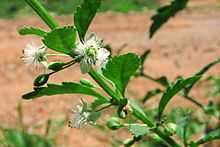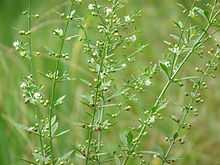Scoparia dulcis
| Scoparia dulcis | |
|---|---|
 | |
| Scientific classification | |
| Kingdom: | Plantae |
| (unranked): | Angiosperms |
| (unranked): | Eudicots |
| (unranked): | Asterids |
| Order: | Lamiales |
| Family: | Plantaginaceae |
| Genus: | Scoparia |
| Species: | S. dulcis |
| Binomial name | |
| Scoparia dulcis L. | |

Scoparia dulcis is a species of flowering plant in the plantain family. Common names include goatweed,[1] scoparia-weed and sweet-broom in English, tapeiçava, tapixaba, and vassourinha in Portuguese, escobillo in Spanish, and tipychä kuratu in Guarani.[2] It is native to the Neotropics but it can be found throughout the tropical and subtropical world.[2]
A medicinal plant, dulcis is used to treat diabetes in India and hypertension in Taiwan.[3] In Brazil it has been used to treat various problems such as hemorrhoids and wounds,[4] while it is used to manage sickle-cell disease in Nigeria[5] and applied to a wide range of problems in Nicaragua, including anemia, burns and headaches.[6] It is also used to protect the stomach from ulcers caused by indomethacin.[7]
In the laboratory, extracts of the plant have been shown to have antihyperglycemic,[3] antimicrobial[8] and antioxidant properties[9][10] Scoparinol, an isolate of the plant, was shown to have analgesic, diuretic, and antiinflammatory activity, as well.[11] Other active principles in the plant have been called scoparic acid, scopadulcic acid, scopadulciol, and scopadulin.[12]
Despite its treatment as a weed in many parts of Bangladesh, duclis's medicinal uses have led to overexploitation..[13] The plant is also found as a weed in Florida citrus groves.[1]
| Wikimedia Commons has media related to Scoparia dulcis. |
References
- ↑ 1.0 1.1 Jain, Rakesh; Singh, Megh (1989). "Factors Affecting Goatweed (Scoparia dulcis) Seed Germination". Weed Science 37 (6): 766–70. JSTOR 4044996.
- ↑ 2.0 2.1 Scoparia dulcis. Germplasm Resources Information Network.
- ↑ 3.0 3.1 Pari, Leelavinothan; Latha, Muniappan (2004). "Protective role of Scoparia dulcis plant extract on brain antioxidant status and lipidperoxidation in STZ diabetic male Wistar rats". BMC Complementary and Alternative Medicine 4: 16. doi:10.1186/1472-6882-4-16. PMC 533881. PMID 15522116.
- ↑ Freire, SM; Torres, LM; Souccar, C; Lapa, AJ (1996). "Sympathomimetic effects of Scoparia dulcis L. And catecholamines isolated from plant extracts". The Journal of pharmacy and pharmacology 48 (6): 624–8. doi:10.1111/j.2042-7158.1996.tb05985.x. PMID 8832498.
- ↑ Murti, Krishna; Panchal, Mayank; Taya, Poonam; Singh, Raghuveer (2012). "Pharmacological Properties of Scoparia Dulcis: A Review". Pharmacologia 3 (8): 344. doi:10.5567/pharmacologia.2012.344.347.
- ↑ Rashid, M. H.; Khalekuzzaman, M.; Hasan, M. F.; Das, R.; Hossain, M. S.; Mahabbat, S.; Mahabbat-e Khoda, S (2009). "Establishment of an Efficient. Method for Micropropagation of an Important Medicinal Herb (Scoparia dulcis L.) from Shoot Tips and Nodal Segments". International Journal of Sustainable Crop Production 4 (1): 5–9.
- ↑ Babincová, Melánia; Schronerová, Kristína; Sourivong, Paul (2008). "Antiulcer activity of water extract of Scoparia dulcis". Fitoterapia 79 (7–8): 587–8. doi:10.1016/j.fitote.2008.05.001. PMID 18621110.
- ↑ Zulfiker, Abu Hasanat; Siddiqua, Masuma; Nahar, Laizuman; Habib, Razibul; Uddin, Nizam; Hasan, Nahid; Rana, Sohel (2011). "In vitro antibacterial, antifungal, and cytotoxic activity of Scoparia dulcis L". International Journal of Pharmacy and Pharmaceutical Sciences 3 (Suppl 2): 198–203.
- ↑ Latha, Muniappan; Pari, Leelavinothan; Sitasawad, Sandhya; Bhonde, Ramesh (2004). "Scoparia dulcis, a traditional antidiabetic plant, protects against streptozotocin induced oxidative stress and apoptosis in vitro and in vivo". Journal of Biochemical and Molecular Toxicology 18 (5): 261–72. doi:10.1002/jbt.20035. PMID 15549711.
- ↑ Coulibaly, Ahmed Y.; Kiendrebeogo, Martin; Kehoe, Patrick G.; Sombie, Pierre A.E.D.; Lamien, Charles E.; Millogo, Jeanne F.; Nacoulma, Odile G. (2011). "Antioxidant and Anti-Inflammatory Effects of Scoparia dulcis L". Journal of Medicinal Food 14 (12): 1576–82. doi:10.1089/jmf.2010.0191. PMID 21870938.
- ↑ Ahmed, M; Shikha, HA; Sadhu, SK; Rahman, MT; Datta, BK (2001). "Analgesic, diuretic, and anti-inflammatory principle from Scoparia dulcis". Die Pharmazie 56 (8): 657–60. PMID 11534346.
- ↑ Zulfiker, Abu Hasanat; Ripa, Farhana Alam; Rahman, Mahbubur; Ullah, M. Obayed; Hamid, Kaiser; Khan, Mahbubur Rahman; Rana, Sohel (2010). "Antidiabetic and antioxidant effect of Scoparia dulcis in alloxan induced albino mice". International Journal of PharmTech Research 2 (4): 2527–34.
- ↑ Majumder, S; Rahman, MM; Bhadra, SK (2011). "Micropropagation of Scoparia dulcis Linn. through induction of indirect organogenesis". Asia-Pacific Journal of Molecular Biology and Biotechnology 19 (1): 11–7.